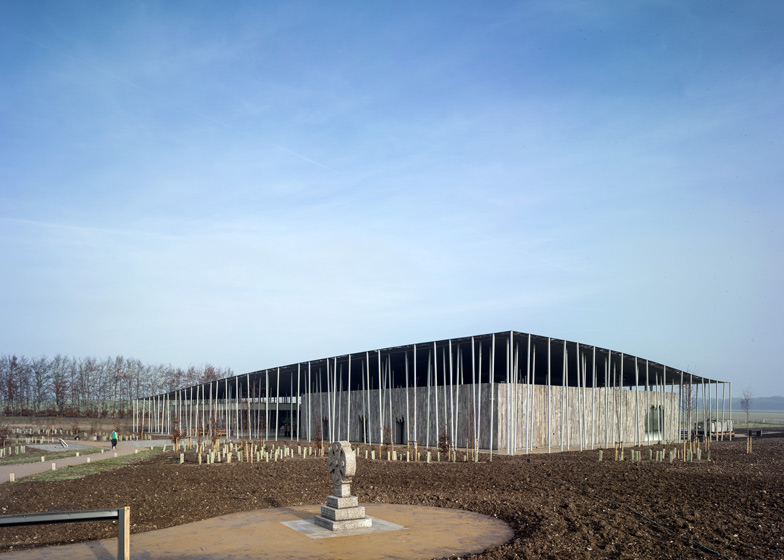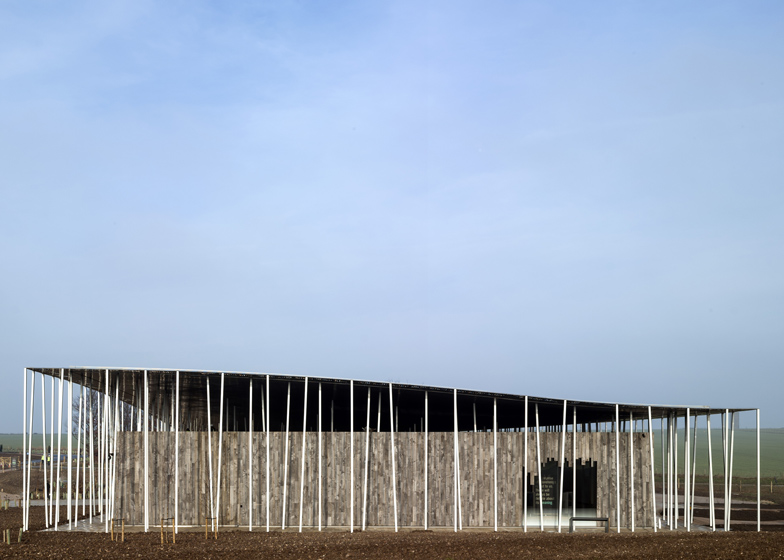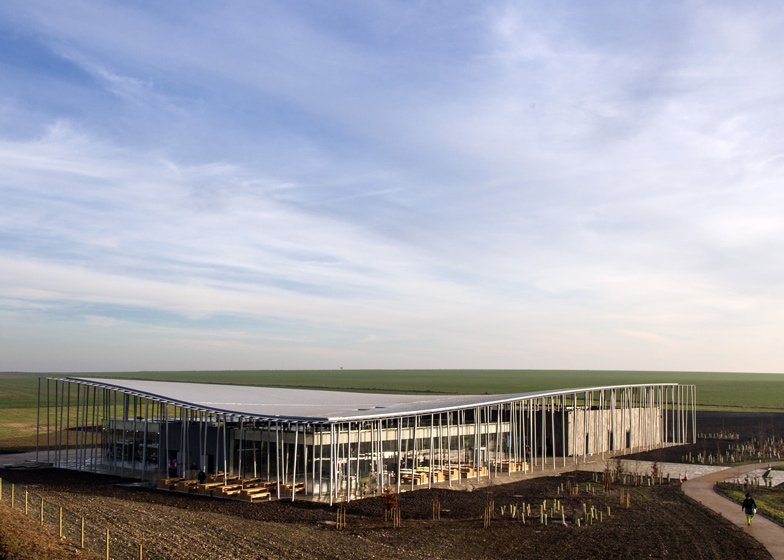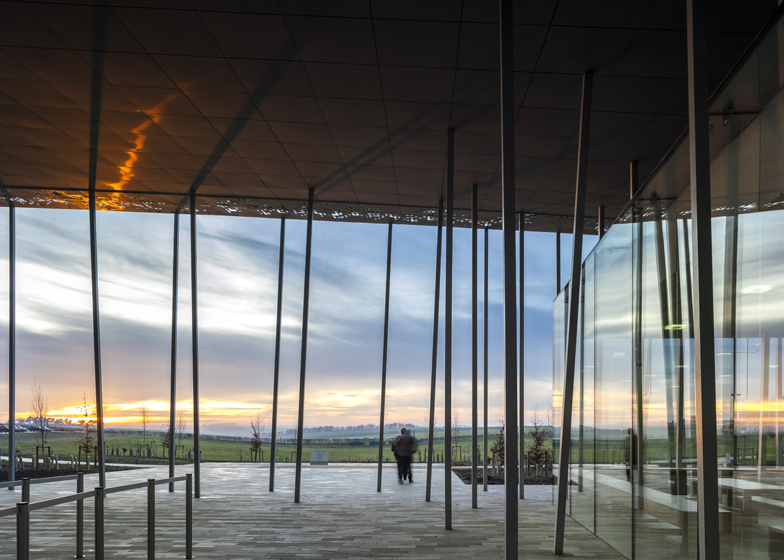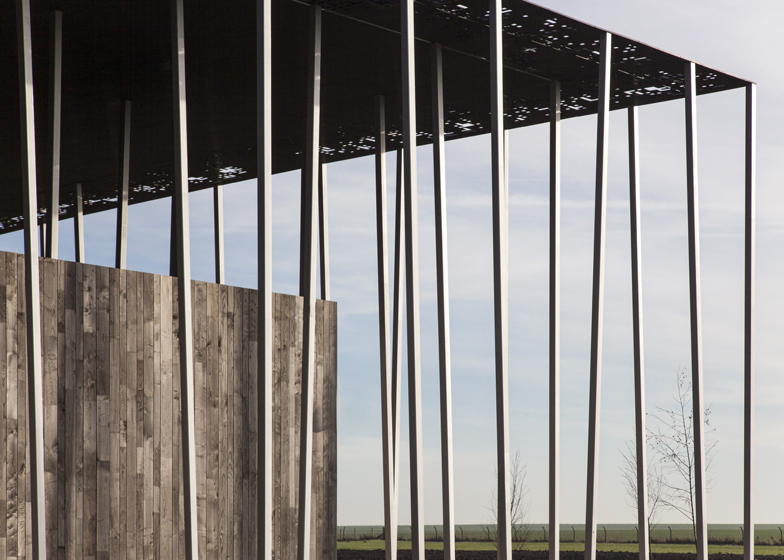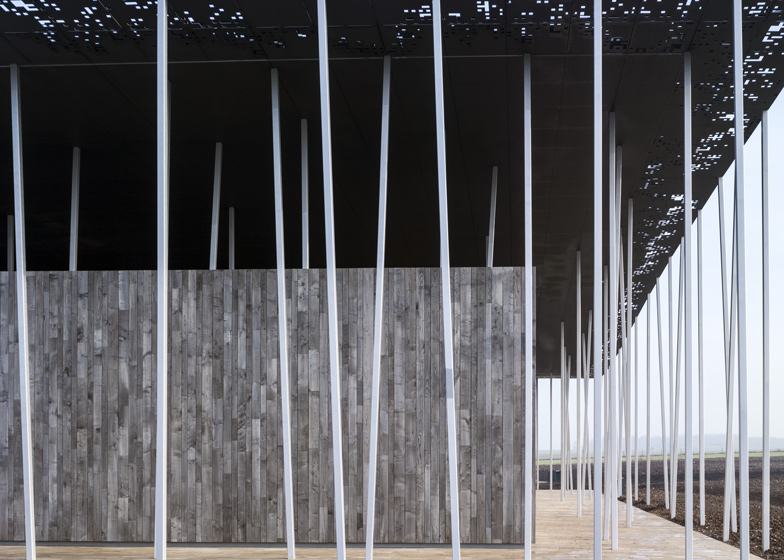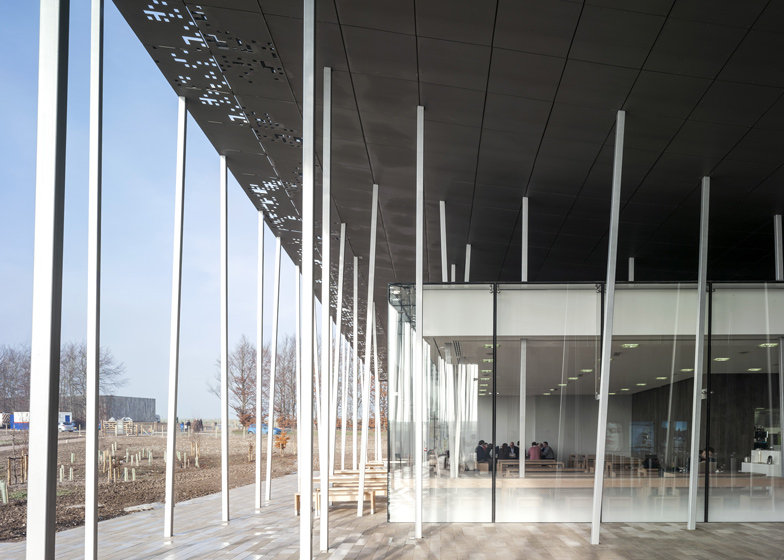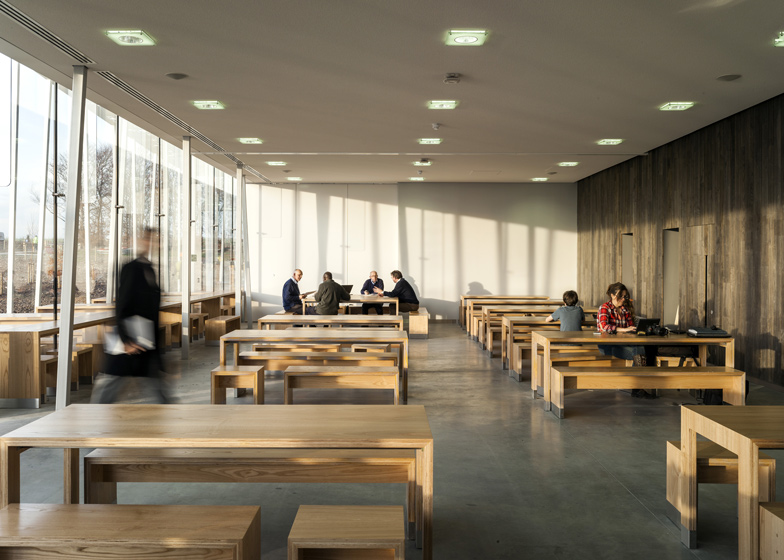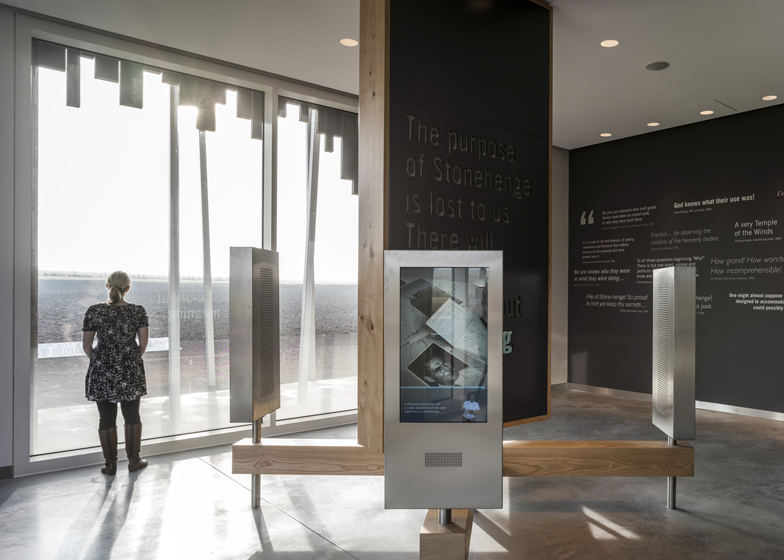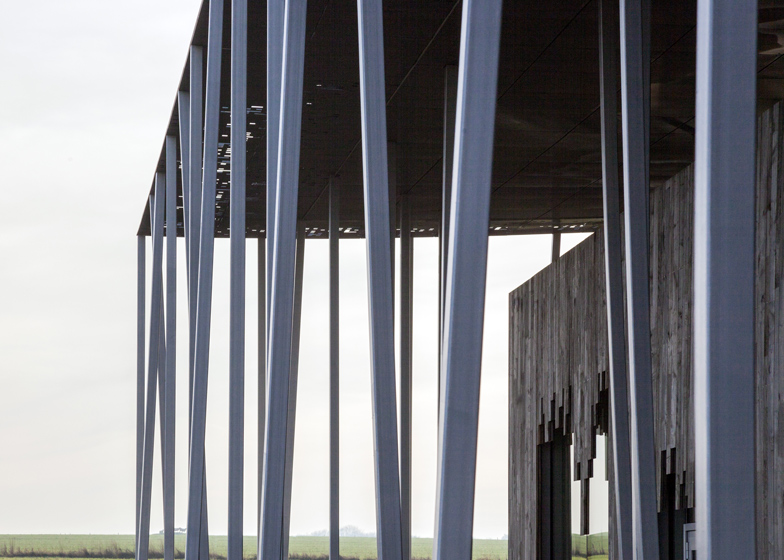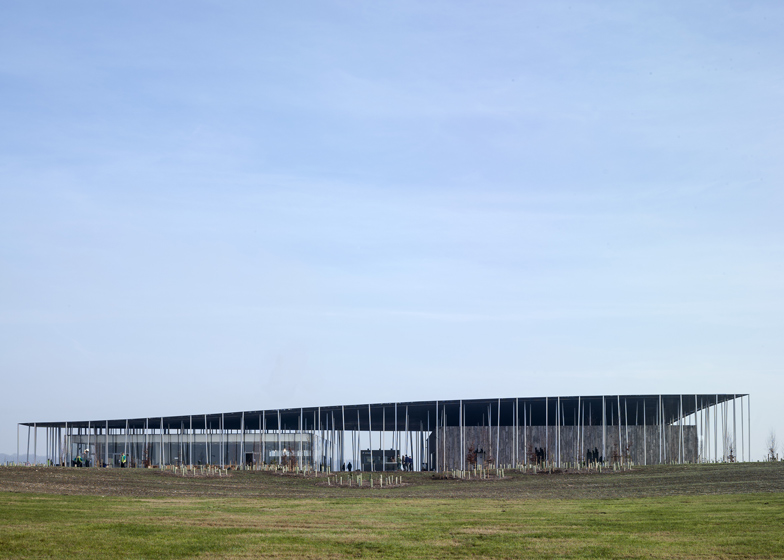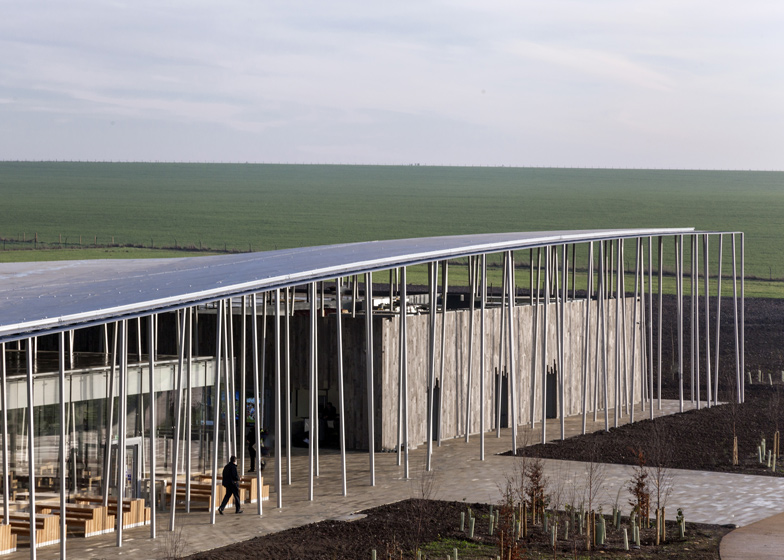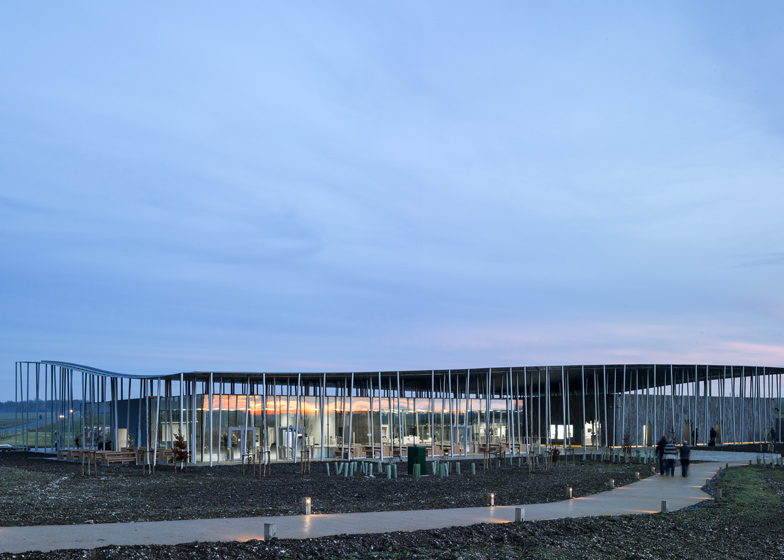News: here are the first photographs of Denton Corker Marshall's visitor centre at Stonehenge - a prehistoric stone circle in England - which finally opens to the public tomorrow (+ slideshow).
After years of negotiations and a string of failed proposals, Denton Corker Marshall's Stonehenge Visitor Centre is now complete on a site 1.5 miles west of the stone circle, within the World Heritage Site but out of site of the ancient monument.
The building comprises three enclosures, all finished with different materials, which are sheltered beneath a undulating steel canopy and surrounded by a forest of over 200 angular steel columns.
The largest block is clad with sweet chestnut wood and houses the museum's exhibition gallery. Another features glass walls and houses an education centre, cafe and shop, while a smaller zinc-clad structure is sandwiched between and functions as a ticket office.
The underside of the steel canopy is clad with zinc panels and features an elaborate pattern of square-shaped perforations. It oversails all three blocks, creating sheltered seating areas around the perimeters.
"The design of the centre is based on the idea that it is a prelude to the stones, and its architectural form and character should in no way diminish their visual impact, sense of timeless strength and powerful sculptural composition," said Denton Corker Marshall's Barrie Marshall.
"Where the stones are exposed, massive and purposefully positioned, the centre is sheltered, lightweight and informal. And where the stones seem embedded into the earth, the centre rests on its surface," he added.
Visitors can walk from the centre to the monument via a winding pathway, or can choose to take a ten-minute shuttle ride.
Photography is by Peter Cook.
Here's the full press release from Denton Corker Marshall:
New Stonehenge Visitor Centre Opens
Denton Corker Marshall’s new Stonehenge Visitor Centre opens its doors on 18th December, inviting more than one million visitors every year to experience the transformed ancient site.
Located 1.5 miles to the west of the stone circle at Airman’s Corner, just within the World Heritage Site but out of sight of the monument, the new visitor centre is designed with a light touch on the landscape - a low key building sensitive to its environment.
Sited within the rolling landforms of Salisbury Plain, the design consists of a subtle group of simple enclosures resting on a limestone platform, all sheltered by a fine, perforated, undulating canopy.
Barrie Marshall, director at Denton Corker Marshall, said: "The design of the centre is based on the idea that it is a prelude to the stones, and its architectural form and character should in no way diminish their visual impact, sense of timeless strength and powerful sculptural composition. Where the stones are exposed, massive and purposefully positioned, the centre is sheltered, lightweight and informal. And where the stones seem embedded into the earth, the centre rests on its surface."
Three pods, finished in different materials, provide the principal accommodation. The largest, clad in sweet chestnut timber, houses the museum displays and service facilities. The second largest, clad in glass, houses the educational base, a stylish café and retail facilities. Located between these is the third, by far the smallest and clad in zinc, which provides ticketing and guide facilities.
Oversailing them all, and resting on 211 irregularly placed sloping columns, is a steel canopy clad on the underside with zinc metal panels and shaped with a complex geometry reflecting the local landforms.
Local, recyclable and renewable materials have been used wherever possible. The material palette includes locally grown sweet chestnut timber cladding and Salisbury limestone.
Stephen Quinlan, partner at Denton Corker Marshall, said: "Various strategies have been adopted in the design to ensure that the centre is environmentally sensitive and uses natural resources in a responsible way. These range from the natural sun shading qualities of the canopy which promotes natural ventilation and reduces the need for cooling in the pods, through to more technical solutions such as heat pumps and high efficiency insulation."
The new building allows Stonehenge to have dedicated facilities on site for education and interpretation for the first time, with museum-quality exhibits that tell the story of the 5,000 year- old monument.
From the new centre, visitors can either walk to the monument or take a ten-minute shuttle ride. During the trip the henge emerges slowly over the horizon to the East.
Dr Simon Thurley, chief executive of English Heritage, said: "For too long, people's appreciation of Stonehenge is this mysterious, impressive but anonymous monument. The Neolithic period itself is pretty much a murky expanse of time, shrouded by many outdated notions. We want people to come here and take away a fresh view."
There will also be an outdoor gallery including the reconstruction of three early Neolithic houses, based on rare forensic evidence found near Stonehenge. These houses will be built by skilled volunteers and are due to be complete by Easter 2014.
Sustainable Design
The building is sensitively designed to sit lightly in the landscape. Reversibility – the ability to return the site to its current state - was a fundamental design concept. The building will last as long as it needs to but could, if necessary, be removed leaving little permanent impact on the landscape.
This is achieved by constructing it on a concrete raft which in turn sits on an area of 'fill' with minimal cutting into the soil. The modern construction, using slender steel columns and lightweight framed walls, and semi-external spaces allow the depth of foundations to be minimised.
Other green features include:
» An open loop ground source heating system that pumps underground water through a unit to extract/inject heat energy. This enables the building to be heated and provides some cooling without the need for fossil fuels.
» Fully insulated cavity walls - the timber pod is constructed of structurally insulated panels (SIPS), which enables efficiencies in construction whilst minimising material waste and ensuring the building is well insulated.
» Mixed mode ventilation – the building will be naturally ventilated whenever external conditions allow, switching to an efficient mechanical ventilation system that enables the heat energy in the exhaust air to be 'recovered' and transferred to the supply air, thereby reducing the load on the heating plant and saving energy.
» "Grey water", including rainwater collected from the roof of the building, will be used for the bulk of water required at the visitor centre, e.g. for flushing toilets. Other water – e.g. for drinking - will be drawn from the aquifer, a local and renewable resource.
» The facilities will use on-site water treatment for sustainability and to avoid intrusive trenching for connections to water and sewer mains.

